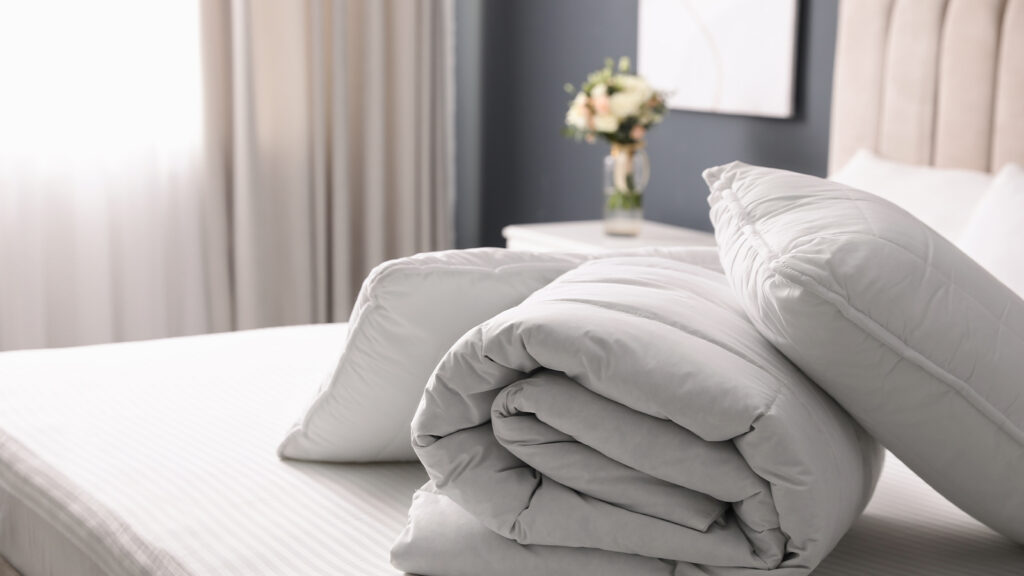
A cozy and stylish bedroom starts with the right bedding, and a duvet cover plays a crucial role in achieving that perfect ambiance. While often mistaken for a comforter itself, a duvet cover is a removable outer layer designed to encase your down or synthetic comforter. This clever design not only protects your comforter from wear and tear but also allows for easy washing and frequent style updates.
This comprehensive guide will delve into the world of duvet covers, exploring their purpose, benefits, materials, and care instructions. By the end, you’ll be equipped with the knowledge to choose the perfect duvet cover that elevates your bedroom decor and ensures a comfortable night’s sleep.
What is a Duvet Cover?
A duvet cover is essentially a large pillowcase for your comforter. It features an opening along one side or at the bottom, allowing you to easily insert and remove your comforter. Duvet covers come in various sizes to match standard comforter dimensions, ensuring a snug fit. They are typically made from soft and breathable fabrics that feel comfortable against your skin.
The primary function of a duvet cover is to protect your comforter from dust, dirt, spills, and everyday wear and tear. By acting as a barrier, it extends the lifespan of your comforter and keeps it clean and fresh. Additionally, duvet covers offer a convenient way to change the look and feel of your bedroom without having to purchase a new comforter.
Benefits of Using a Duvet Cover
There are numerous advantages to using a duvet cover:
- Easy Washing: Duvet covers can be easily removed and washed, making it simple to keep your bedding clean and hygienic.
Style Versatility: With a wide range of colors, patterns, and designs available, duvet covers allow you to effortlessly update the look of your bedroom to match your personal style or seasonal preferences.
Protection for Your Comforter: The outer layer of a duvet cover shields your comforter from dust mites, allergens, and other potential contaminants, keeping it clean and healthy.
- Enhanced Comfort: Some duvet covers are made with special fabrics that offer additional comfort features, such as moisture-wicking properties or temperature regulation.
Choosing the Right Duvet Cover
Selecting the perfect duvet cover involves considering several factors:
Size: Ensure you choose a duvet cover that matches the size of your comforter. Common sizes include twin, full/queen, king, and California king.
Material: Different materials offer varying levels of warmth, breathability, and durability. Popular choices include cotton, linen, silk, and flannel.
* Warmth Level: Consider the climate you live in and your personal preference for warmth. Down-alternative or synthetic fill comforters are generally warmer than those filled with natural down.
Style: Choose a duvet cover that complements your existing bedding ensemble and reflects your personal style.
Duvet Cover Materials
A variety of materials are used to create duvet covers, each offering unique characteristics:
- Cotton: A classic choice known for its softness, breathability, and durability. Cotton duvet covers are easy to care for and come in a wide range of colors and patterns.
Linen: Linen is a natural fiber that is highly breathable and moisture-wicking, making it ideal for warm climates. It has a slightly textured feel and becomes softer with each wash.
Silk: Silk duvet covers are luxurious and known for their smooth, silky texture. They offer excellent temperature regulation and are hypoallergenic.
- Flannel: Flannel is a soft and cozy fabric that is perfect for colder months. Its brushed surface creates a warm and fuzzy feel against the skin.
Care and Maintenance
Proper care ensures your duvet cover remains clean, fresh, and lasts longer:
- Washing Instructions: Most duvet covers can be machine washed in cold water on a gentle cycle. Check the care label for specific instructions.
- Drying: Tumble dry on low heat or air dry to prevent shrinkage and damage. Avoid using high heat settings.
- Ironing: If ironing is necessary, use a low setting and avoid pressing directly on any embellishments.
Storage: When not in use, store your duvet cover in a clean and dry place. Avoid storing it in damp areas or near direct sunlight.
Conclusion
A duvet cover is an essential element of a comfortable and stylish bedroom. By understanding the benefits, choosing the right material and size, and following proper care instructions, you can enjoy a cozy and inviting sleep environment for years to come. Whether you prefer a classic cotton design or a luxurious silk option, there’s a perfect duvet cover out there to complement your personal style and enhance your sleep experience.
